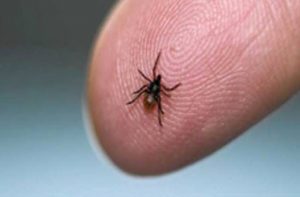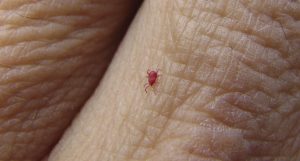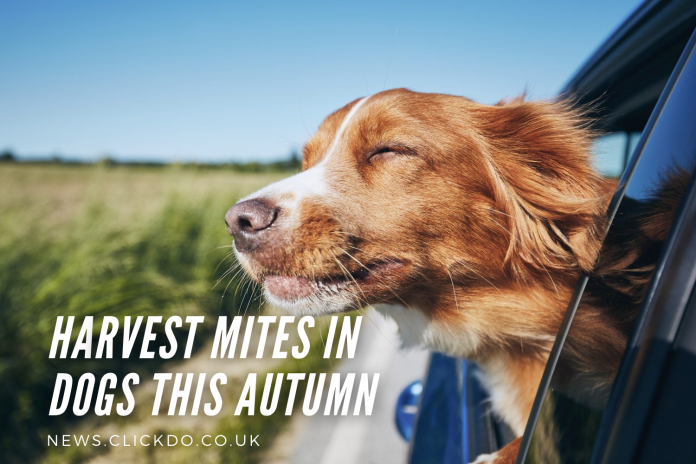With late autumn approaching fast, spending a lot of time with your dog outdoors can carry some risks such as an infestation of harvest mites in dogs.
Whether you are involved in dog breeding or just a dog owner, it is good to get an idea about harvest mites and possible treatment options.
Harvest mites on dogs, also known as red bugs, trombiculid mites, scrub-itch mites, berry bugs, or, in their larval stage as chiggers, are one of the biggest nightmares for dog owners and breeders as they cause intensely itchy and red inflammation of the dog’s skin.
They are almost microscopic, with a size of 1/100 of an inch (0.4 mm). If we zoom onto these microscopic organisms, we will that they have an orange hue. The most common species in North America is Trombicula alfreddugesi.
They are usually found in forests and grasslands, which is where dogs like to run. These species are in the family group of spiders. The most infected areas are feet, legs, and sometimes the ears.
Even though this infection can be irritating for your dog, once it gets cured, you both do not need to worry about it further.
General Information about the Harvest Mites Infestations in Dogs
 Harvest mites, (Neotrombicula autumnalis) are orange-hued microscopic organisms that live in the soil. They are most common in woodland and grassy areas. They normally feed upon the animals they encounter; hence they are parasitic.
Harvest mites, (Neotrombicula autumnalis) are orange-hued microscopic organisms that live in the soil. They are most common in woodland and grassy areas. They normally feed upon the animals they encounter; hence they are parasitic.
These microscopic organisms are found to be thriving from July to November, hence late autumn is a season of caution.
Once your dogs encounter Neotrombicula autumnalis or harvest mites, they will feel itchy and very uncomfortable. Many dogs are sensitive to the salivation of this organism, developing intensely itchy, red, and inflamed skin wherever they’re bitten.
As stated above, the infections of harvest mite infestations in dogs are found in the following areas – between toes, on the feet, legs, armpits, genitals, tummy, and can at times affect the ears, so look out for those signs.
What Do Harvest Mites Do to Dogs?
 The harvest mites attack the warm-blooded animals at their larvae stage to gain nutrition. They attach themselves to the surface of their prey. They usually have small, hooked fangs that pierce the skin and inject powerful enzymes that are capable of liquifying the skin cells for consumption. These enzymes would be irritating for the warm-blooded dog, thus causing it to bite or scratch itself, possibly causing self-inflicted wounds. The result would be minor wounds, hair loss, bare skin, soft and moist bloodied areas, etc. Further complications would lead to the loss of hair permanently or infections.
The harvest mites attack the warm-blooded animals at their larvae stage to gain nutrition. They attach themselves to the surface of their prey. They usually have small, hooked fangs that pierce the skin and inject powerful enzymes that are capable of liquifying the skin cells for consumption. These enzymes would be irritating for the warm-blooded dog, thus causing it to bite or scratch itself, possibly causing self-inflicted wounds. The result would be minor wounds, hair loss, bare skin, soft and moist bloodied areas, etc. Further complications would lead to the loss of hair permanently or infections.
Do Harvest Mites Pose Any Danger?
 Most of us would think of a harvest mite infestation as being like a flea infestation, but that’s not it.
Most of us would think of a harvest mite infestation as being like a flea infestation, but that’s not it.
Even though it is not fully proven by veterinarians or researchers, Seasonal Canine Illness (SCI) is one of the illnesses to look out for if you are a dog owner, and you think that your dog has been infected by harvest mites. This is a surprisingly common occurrence during the autumn months, and on rare occasions can prove to be fatal.
So, to be on the safe side, it is always better to take your dog for a walk in areas with no or very short grass or on the roads rather than in a woody or grassy area during the July to November period.
How Do I Treat Harvest Mites?
 If you have a suspicion that your dog has been infested by harvest mites, then you should take them to the veterinarian to seek advice and a professional assessment. Vets would be able to understand the severity of the situation, and then would be able to prescribe safe and adequate treatment.
If you have a suspicion that your dog has been infested by harvest mites, then you should take them to the veterinarian to seek advice and a professional assessment. Vets would be able to understand the severity of the situation, and then would be able to prescribe safe and adequate treatment.
Currently, there are no such flea treatments for any kind of pet animal in the market. But many insecticides are useful for killing such harvest mites when applied correctly. It is always recommended to choose products that have a long-lasting effect and will help with controlling the infestation and prevent it to an extent.
Please don’t heed the common advice of applying alcohol, as it will not kill the chiggers or help with symptoms. It will only cause burning, pain, and discomfort for your pet.
What Can I Do to Stop the Itching?
 Most dogs do not need any sort of extra treatments or medication once all the harvest mites are killed. But certain breeds can be very sensitive. Hence, after visiting your veterinarian, additional treatments with anti-inflammatory medications may be required. In cases where the infestation has crossed the first stage, antibiotics may be needed too.
Most dogs do not need any sort of extra treatments or medication once all the harvest mites are killed. But certain breeds can be very sensitive. Hence, after visiting your veterinarian, additional treatments with anti-inflammatory medications may be required. In cases where the infestation has crossed the first stage, antibiotics may be needed too.
Do Harvest Mites Affect People?
 Humans can also become victims of harvest mite infestations. But they don’t get it from their animal friends; they get in contact with them while being active outdoors. These parasitic organisms attach themselves to the ankles mostly.
Humans can also become victims of harvest mite infestations. But they don’t get it from their animal friends; they get in contact with them while being active outdoors. These parasitic organisms attach themselves to the ankles mostly.
The most common skin reaction would be intensely irritating rashes. There are no exclusive treatments for this, as it tends to go away while bathing. But it is always recommended to wear full-body covering clothes during this time while being active outdoors in woody and grassy areas.
Final Thoughts
Now that autumn is just around the corner, every dog owner and breeder should know about harvest mites and the symptoms an infestation can cause to their dogs. Recognizing the symptoms earlier will help with a swift and less irritating treatment and recovery for the dog. And preventing such an infestation is simple by just avoiding high grass and woodlands in autumn and protecting your dog’s skin with a dog coat for example. So, all it takes is precaution and awareness. Feel free to share this knowledge with your dog owner or breeder friends!





























